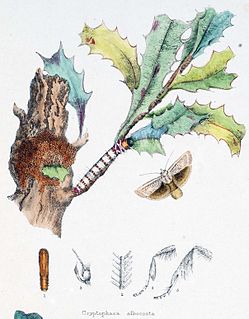Lambula is a genus of moths in the family Erebidae. The genus was erected by Francis Walker in 1866.

Lichenaula is a genus of Australian moth of the family Xyloryctidae.
Blastobasis transcripta is a moth in the family Blastobasidae. It is found in India.
Lambula hypopolius is a moth of the family Erebidae first described by Walter Rothschild in 1916. It is found along the coastline of northern New Guinea, from Papua New Guinea and Karkar Island to Batanta Island.
Lambula aroa is a moth of the family Erebidae. It was described by George Thomas Bethune-Baker in 1904. It is widely distributed in New Guinea, where it is found in the Central Mountain Range. In Papua New Guinea it is only found east from the Baliem Valley.
Lambula bivittata is a moth of the family Erebidae. It was described by Walter Rothschild in 1912. It is thought to be endemic to Papua New Guinea. The habitat consists of mountainous areas.
Lambula flavobrunnea is a moth of the family Erebidae. It was described by Walter Rothschild in 1912. It is found in Papua, Indonesia, where it is distributed in the Central Mountain Range.
Lambula laniafera is a moth of the family Erebidae. It was described by George Hampson in 1900. It is found in Papua, Indonesia.
Lambula punctifer is a moth of the family Erebidae. It was described by George Hampson in 1900. It is known only from a few specimens collected on New Guinea, including Fakfak, the Setekwa River and the Utakwa River.
Lambula umbrina is a moth of the family Erebidae. It was described by Walter Rothschild in 1915. It is only known from the holotype, which was collected near the Utakwa River in the Snow Mountains of Papua.
Lambula buergersi is a moth of the family Erebidae. It was described by Max Gaede in 1925. It is found in Papua New Guinea. It was previously only known from Mulu, the type locality, but was later also collected in the Foja Mountains.
Lambula pristina is a moth of the family Erebidae. It was described by Francis Walker in 1866. It is found in Australia.
Lambula aethalocis is a moth of the family Erebidae. It was described by George Hampson in 1914. It is found on New Guinea.
Lambula agraphia is a moth of the family Erebidae. It was described by George Hampson in 1900. It is found on New Guinea.
Lambula melaleuca is a moth of the family Erebidae. It was described by Francis Walker in 1866. It is found on the Moluccas. It is the type species of the genus Lambula.
Lambula malayana is a moth of the family Erebidae. It was described by Jeremy Daniel Holloway in 1982. It is found in Malaysia.
Lambula pleuroptycha is a moth of the family Erebidae. It was described by Alfred Jefferis Turner in 1940. It is found in Australia, where it has been recorded from the Northern Territory, Queensland and New South Wales.
The Lithosiina are a subtribe of lichen moths in the family Erebidae. The taxon was erected by Gustaf Johan Billberg in 1820.

Cryptophasa is a genus of moths of the family Xyloryctidae.

